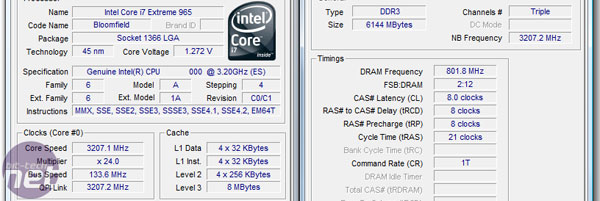Intel Core i7 Memory Performance
This has been one of those features we were planning to do soon after Core i7 launched, then had to put back. Before we go any further, we should say thank you to Corsair for being patient with us (!!), but we felt we had to address the key questions with this new architecture first, before reviewing memory. After all, if you don't know how long a yard stick is, how can you tell if other sticks measure up well?If you've been living under a rock the last few months, or you're new to the field of performance hardware (welcome! - Ed.) then lets have a quick Core i7 CPU and memory architecuture refresher.
For the first time in the Intel camp, the Core i7 CPU now houses not only its execution cores, but also an "Uncore" area that also contains the memory controller, L3 cache and QPI interconnect to the X58 northbridge on the motherboard. The "Uncore" area runs at a different frequency to the CPU cores, so it's essential to know both these values which are indicative of performance and overclocking potential.
With its direct connection to three channels of DDR3 memory, not only is the bandwidth absolutely massive compared to anything we've seen before, but the latency to access it is also very low as well - effectively the best of both worlds. In this respect, it's left us wondering: does memory frequency or memory latency have the biggest effect on Core i7 systems? Do either? Can you just bung three cheap memory modules in a new Nehalem build and get the same performance as expensive sticks, or is there more to it than that?
We've gone through and tested 1,066MHz (the stock Core i7 memory frequency), 1,333MHz and 1,600MHz memory speeds, to see the differences in increasing frequency, in addition to timing reductions on each one, from the slowest 9-9-9-24-1T, through 8-8-8-21-1T, 7-7-7-18-1T to even 6-6-6-15-1T, and thanks to the very capable Asus P6T Deluxe, even as low as 5-5-5-15-1T too in some cases. We've compared to 1T to 2T Command Rate and also looked at several Uncore frequencies in order to ascertain whether increasing the memory controller (and L3 cache) frequency affects the results significantly too.
Weapon of Choice
This is where Corsair comes in - it has hooked us up with a 6GB triple channel kit of its latest 1,600MHz C8 DDR3 modules with Dominator DHX+cooling technology (the funky hair style) in order to put the 965XE and P6T Deluxe through its paces. In typical review fashion, we'll also be overclocking the memory for all its worth, trying to understand if Corsair's new DHX+ is really up to the hype and worth exchanging with the cash in your wallet.Manufacturer: Corsair Memory
UK Price (as reviewed): £194.41 (inc. VAT)
US Price (as reviewed): $229.99 (ex. Tax)
- Kit: 3 x 240-pin DDR3 Double Sided DIMM
- Module Size: 6GB Triple Channel Kit (3 x 2GB)
- Module Code: TR3X6G1600C8D
- Rated Speed: 1,600MHz
- Rated Timings: 8-8-8-24
- Rated Voltage: 1.65V
- Memory Chips: Elpida (v2.1 - First Gen)
- XMP: Yes
The 6GB of memory comes from three 2GB matched modules, underneath they use a Elpida IC and black Corsair branded PCB to match the heatsinks on the side. Corsair's PCB is still tall, like the original DHX heasinks, but now instead of having inner and outer 'sinks, the two sides are just one large block of copper firmly affixed to the ICs and sealed to the PCB above with glue (which Corsair claims there is some thermal transfer properties in as well).
On top, and for the first time is a customisable heatsink fin module screwed into place with three torx. Here they are black, but in the GT modules it's a punk red instead. The SPD is set to 1,333MHz at 9-9-9-24, however it does feature an Intel XMP setting of its rated 8-8-8-24 at 1,600MHz. Most Intel X58 boards will support XMP memory and set the system clock speeds, and sometimes the voltages accordingly, but it's still worth checking none-the-less.
Coupled with the usual awesome lifetime warranty from Corsair this is pretty much an industry standard from performance memory makers (OCZ, G.Skill, Patriot Memory and Team Group to name just a few), but we still love it all the same.

MSI MPG Velox 100R Chassis Review
October 14 2021 | 15:04














Want to comment? Please log in.